1 Getting to Know the Work Area
Lesson overview
In this lesson, you’ll explore the workspace and learn how to do the following:
-
Open an Adobe Illustrator CC file.
-
Work with the Tools panel.
-
Work with panels.
-
Reset and save your workspace.
-
Use viewing options to change the display magnification.
-
Navigate multiple artboards and documents.
-
Explore document groups.
-
Find resources for using Illustrator.

This lesson takes approximately 45 minutes to complete. Please log in to your account
on peachpit.com to download the lesson files for this chapter, or go to the “Getting Started” section
at the beginning of this book and follow the instructions under “Accessing the lesson
files and Web Edition.”
Your Account page is also where you’ll find any updates to the chapters or to the
lesson files. Look on the Lesson & Update Files tab to access the most current content.

To make the most of the extensive drawing, painting, and editing capabilities of Adobe
Illustrator CC, it’s important to learn how to navigate the workspace. The workspace
consists of the Application bar, menus, Tools panel, Properties panel, Document window,
and other default panels.
Introducing Adobe Illustrator
In Illustrator, you primarily create and work with vector graphics (sometimes called
vector shapes or vector objects). Vector graphics are made up of lines and curves defined by mathematical objects called vectors. You can freely move or modify vector graphics without losing detail or clarity because
they are resolution-independent.
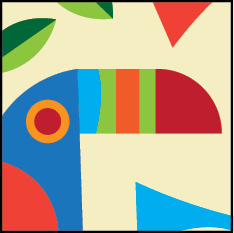
An example of vector artwork.

Editing vector artwork.
In other words, vector graphics maintain crisp edges when they are resized, printed
to a PostScript printer, saved in a PDF file, or imported into a vector-based graphics
application. As a result, vector graphics are the best choice for artwork, such as
logos, that will be used at various sizes and in various output media.
 Tip: To learn more about bitmap graphics, search for “Importing bitmap images” in Illustrator
Help (Help > Illustrator Help).
Tip: To learn more about bitmap graphics, search for “Importing bitmap images” in Illustrator
Help (Help > Illustrator Help).
Illustrator also allows you to incorporate bitmap images—technically called raster images—that use a rectangular grid of picture elements (pixels) to represent the visual.
Each pixel is assigned a specific location and color value. Pictures you take on your
phone camera are considered raster images. Raster images can be created and edited
in a program like Adobe Photoshop.

Example of a raster image and a zoomed–in portion to show the pixels.
Starting Illustrator and opening a file
In this first lesson, you’ll begin by exploring Illustrator. You’ll open a few art
files during this lesson, but before you begin, you’ll restore the default preferences
for Adobe Illustrator CC. This is something you will do at the start of each lesson
in this book to ensure that the tools function and the defaults are set exactly as
described in this lesson.
-
To delete or deactivate (by renaming) the Adobe Illustrator CC preferences file, see
“Restoring default preferences” in the “Getting Started” section at the beginning
of the book.
-
Double-click the Adobe Illustrator CC icon to launch Adobe Illustrator.
With Illustrator open, you will see a start screen showing resources for Illustrator,
and more.
-
Choose File > Open or click the Open button in the Start screen. In the Lessons >
Lesson01 folder on your hard disk, select the L1_start1.ai file, and click Open. You
will use the L1_start1.ai file to practice navigating, zooming, and investigating
an Illustrator document and the workspace.
 Note: If you have not already downloaded the project files for this lesson to your computer
from your Account page, make sure to do so now. See the “Getting Started” section
at the beginning of the book.
Note: If you have not already downloaded the project files for this lesson to your computer
from your Account page, make sure to do so now. See the “Getting Started” section
at the beginning of the book.
 Note: If a Tour window appears after opening the document, you can simply close it. Do
the same thing going forward for each lesson.
Note: If a Tour window appears after opening the document, you can simply close it. Do
the same thing going forward for each lesson.
-
Choose Window > Workspace > Essentials, make sure it’s selected, and then choose Window
> Workspace > Reset Essentials to reset the workspace.
The Reset Essentials command ensures that the workspace, which includes all of the
tools and panels, is set to the default settings.
-
Choose View > Fit Artboard In Window.
An artboard is the area that contains your printable artwork and is similar to a page
in Adobe InDesign®. This command fits the whole artboard into the Document window so that you can see
the entire artboard.
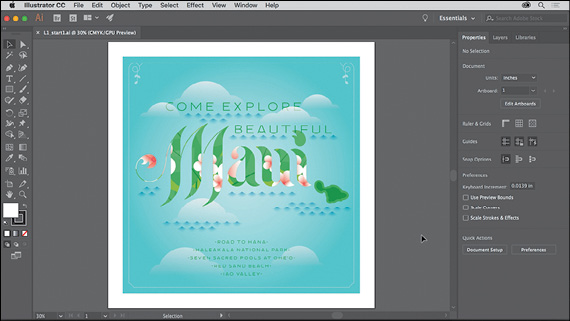
When the file is open and Illustrator is fully launched, the menus, Application bar,
Tools panel, and panels appear on the screen.
Exploring the workspace
 Note: The figures in this lesson are taken using the macOS operating system and may look
slightly different from what you see, especially if you are using Windows.
Note: The figures in this lesson are taken using the macOS operating system and may look
slightly different from what you see, especially if you are using Windows.
You create and manipulate your documents and files using various elements, such as
panels, bars, and windows. Any arrangement of these elements is called a workspace. When you first start Illustrator, you see the default workspace, which you can customize
for the tasks you perform. You can create and save multiple workspaces—one for editing
and another for viewing, for example—and switch among them as you work.
Below, the areas of the default workspace are described:
-
The Application bar across the top by default contains application controls, the Workspace Switcher,
and Search. On Windows, the menu items appear inline with the Application bar—see the following figure.

-
Panels help you monitor and modify your work. Certain panels are displayed by default, and
you can display any panel by choosing it from the Window menu.
-
The Tools panel contains tools for creating and editing images, artwork, page elements, and more.
Related tools are grouped together.
-
The Document window displays the file(s) you’re working on.
-
The Status bar appears at the lower-left edge of the Document window. It displays information, zooming,
and navigation controls.
Getting to know the Tools panel
The Tools panel on the left side of the workspace contains tools for selecting, drawing
and painting, editing, and viewing, as well as the Fill and Stroke boxes, drawing
modes, and screen modes. As you work through the lessons, you’ll learn about the specific
function of many of these tools.
 Note: The Tools panel shown here and throughout this lesson has two columns. You may see
a one-column Tools panel, depending on your screen resolution and workspace.
Note: The Tools panel shown here and throughout this lesson has two columns. You may see
a one-column Tools panel, depending on your screen resolution and workspace.
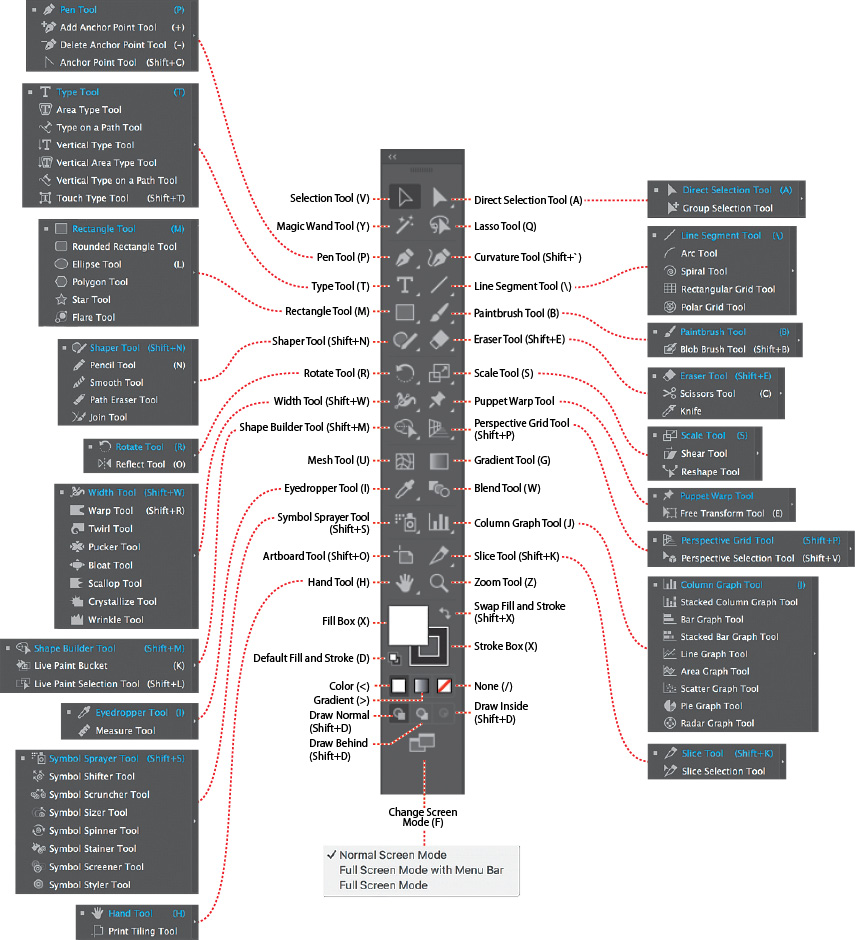
-
Position the pointer over the Selection tool ( ) in the Tools panel. Notice that the name (Selection Tool) and keyboard shortcut
(V) are displayed in a tooltip.
) in the Tools panel. Notice that the name (Selection Tool) and keyboard shortcut
(V) are displayed in a tooltip.
 Tip: You can modify the default keyboard shortcuts that Illustrator comes with. To do
this, choose Edit > Keyboard Shortcuts. For more information, see “Keyboard Shortcuts”
in Illustrator Help (Help > Illustrator Help).
Tip: You can modify the default keyboard shortcuts that Illustrator comes with. To do
this, choose Edit > Keyboard Shortcuts. For more information, see “Keyboard Shortcuts”
in Illustrator Help (Help > Illustrator Help).
 Tip: You can turn the tooltips on or off by choosing Illustrator CC > Preferences > General
(macOS) or Edit > Preferences > General (Windows) and deselecting Show Tool Tips.
Tip: You can turn the tooltips on or off by choosing Illustrator CC > Preferences > General
(macOS) or Edit > Preferences > General (Windows) and deselecting Show Tool Tips.
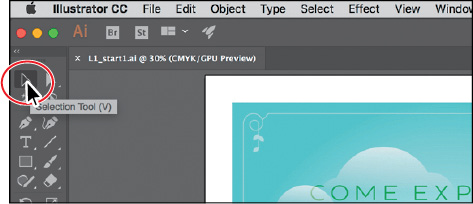
-
Move the pointer over the Direct Selection tool ( ), and click and hold down the mouse button until a tools menu appears. Release the
mouse button and then click the Group Selection tool to select it.
), and click and hold down the mouse button until a tools menu appears. Release the
mouse button and then click the Group Selection tool to select it.
Any tool in the Tools panel that displays a small triangle contains additional tools
that can be selected in this way.
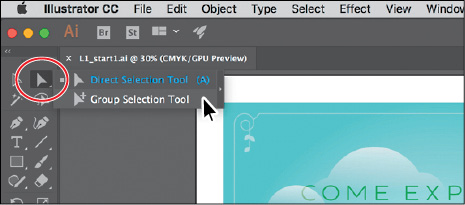
-
Click and hold down the mouse button on the Rectangle tool ( ) to reveal more tools. Click the arrow at the right edge of the hidden tools panel
to separate the tools from the Tools panel so that you can access them at all times.
) to reveal more tools. Click the arrow at the right edge of the hidden tools panel
to separate the tools from the Tools panel so that you can access them at all times.
 Tip: You can also select hidden tools by pressing the Option key (macOS) or the Alt key
(Windows) and clicking the tool in the Tools panel. Each click selects the next hidden
tool in the tool sequence.
Tip: You can also select hidden tools by pressing the Option key (macOS) or the Alt key
(Windows) and clicking the tool in the Tools panel. Each click selects the next hidden
tool in the tool sequence.
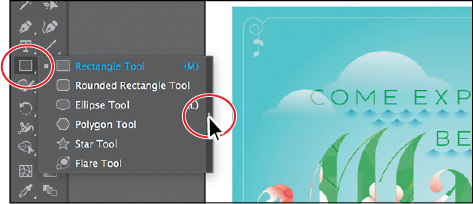
-
Click the Close button (X) in the upper-left corner (macOS) or upper-right corner
(Windows) on the floating tool panel’s title bar to close it. The tools return to
the Tools panel.
 Tip: You can also collapse the floating tool panels or dock them to the workspace or each
other.
Tip: You can also collapse the floating tool panels or dock them to the workspace or each
other.
Next, you’ll learn how to resize and float the Tools panel. In the figures in this
lesson, the Tools panel is a double column by default. As I said before, you may see
a single-column Tools panel to start with, depending on your screen resolution and
workspace, and that’s okay.
-
Click the double arrow in the upper-left corner of the Tools panel to either expand
the one column into two columns or collapse the two columns into one (depending on
your screen resolution).

-
Click the same double arrow again to expand (or collapse) the Tools panel.
-
Click the dark gray title bar at the top of the Tools panel or the dashed line beneath
the title bar, and drag the Tools panel into the workspace. The Tools panel is now
floating in the workspace.

 Tip: You can click the double arrow at the top of the Tools panel or double-click the
title bar at the top of the Tools panel to switch between two columns and one column.
Just be careful not to click the X or it will close! If you close it, choose Window
> Tools > Default to open it again.
Tip: You can click the double arrow at the top of the Tools panel or double-click the
title bar at the top of the Tools panel to switch between two columns and one column.
Just be careful not to click the X or it will close! If you close it, choose Window
> Tools > Default to open it again.
-
To dock the Tools panel again, drag its title bar or the dashed line below it to the
left side of the Application window. When the pointer reaches the left edge, a translucent
blue border, called the drop zone, appears. Release the mouse button to dock the Tools panel neatly into the side of
the workspace.
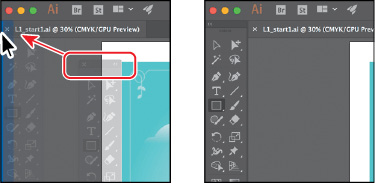
Working with the Properties panel
When starting Illustrator for the first time and opening a document, you’ll see the
Properties panel on the right side of the workspace. The Properties panel displays
properties for the active document when nothing is selected, and appearance properties
for content you select. It puts all of the most commonly used options in one place,
and it’s a panel you will be using quite a bit.
-
Select the Selection tool ( ) in the Tools panel, and look in the Properties panel on the right.
) in the Tools panel, and look in the Properties panel on the right.
At the top of the Properties panel, you will see “No Selection.” This is called the
Selection Indicator and is a great place to look and see what type of content is selected
(if any). The properties in the Properties panel are currently for the current document
properties and program preferences.
-
Move the pointer into the blue background in the artwork, and click to select it.
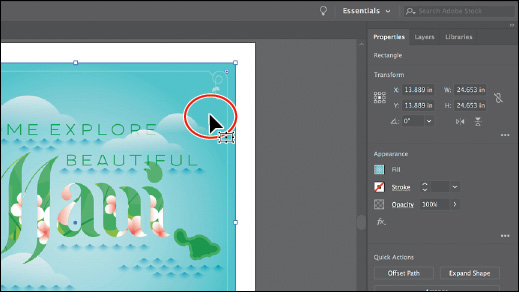
In the Properties panel, you should now see appearance options for the selected artwork.
You can change the size, position, color, and much more for the artwork you selected.
The artwork selected is a rectangle, as indicated by “Rectangle” at the top of the
panel.
-
Click the underlined word “Opacity” in the Properties panel to open the Transparency
panel options. Words that are underlined in the Properties panel will show more options
when you click them.
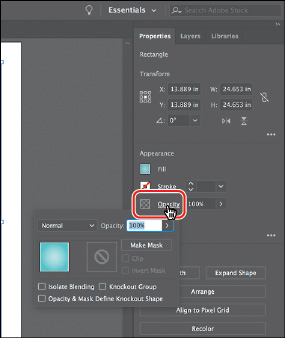
-
Press Escape to hide the Transparency panel, if necessary.
-
Choose Select > Deselect to deselect the rectangle.
The Properties panel once again shows the default properties when nothing is selected.
Working with panels
Panels in Illustrator, like the Properties panel, give you quick access to many of
the tools and options that make modifying artwork easier. All of the panels available
in Illustrator are listed alphabetically in the Window menu. Next, you’ll experiment
with hiding, closing, and opening panels.
-
Click the Layers panel tab to the right of the Properties panel tab.

The Layers panel appears with two other panels—the Properties panel and the Libraries
panel. They are all part of the same panel group.
 Tip: To find a hidden panel, choose the panel name from the Window menu. A checkmark to
the left of the panel name indicates that the panel is already open and in front of
other panels in its panel group. If you choose a panel name that is already selected
in the Window menu, the panel and its group either close or collapse.
Tip: To find a hidden panel, choose the panel name from the Window menu. A checkmark to
the left of the panel name indicates that the panel is already open and in front of
other panels in its panel group. If you choose a panel name that is already selected
in the Window menu, the panel and its group either close or collapse.
-
Click the double arrow at the top of the dock to collapse the panels.
 Tip: To expand or collapse the panel dock, you can also double-click the panel dock title
bar at the top.
Tip: To expand or collapse the panel dock, you can also double-click the panel dock title
bar at the top.

You can use this method of collapsing the panels so you have more area to work on
your document.
-
Drag the left edge of the docked panels to the right until the panel text disappears.
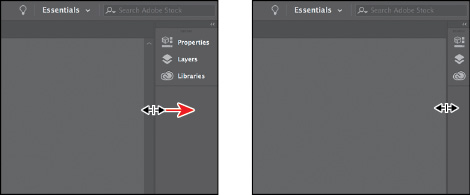
This hides the panel names and collapses the panel dock to icons only. In order to
open a panel when collapsed as an icon, you can click a panel icon.
-
Click the double arrow again to expand the panels.
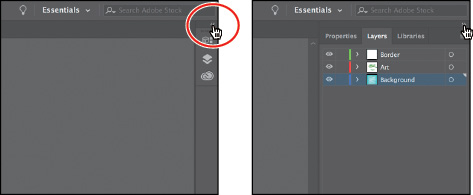
-
Choose Window > Workspace > Reset Essentials to reset the workspace.
Docking panels
Panels in Illustrator can be moved around in the workspace and organized to match
your working needs. Next, you’ll open a new panel and dock it with the default panels
on the right side of the workspace.
-
Click the Window menu at the top of the screen to see all of the panels available
in Illustrator. Choose Align in the Window menu to open the Align panel and the other
panels grouped with it by default.
Panels you open that do not appear in the default workspace are free-floating. That
means they are not docked and can be moved around. You can dock free-floating panels
on the right or left side of the workspace.
-
Drag the Align panel group by the title bar above the panel names to position the
group closer to the docked panels on the right.
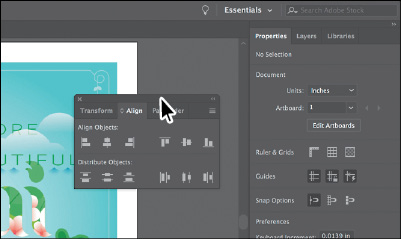
Next, you’ll dock the Align panel with the Properties panel.
-
Drag the Align panel tab away from the panel group and onto the panel tabs (Properties,
Layers, and Libraries) at the top of the docked panels. When a blue highlight appears
around the entire panel dock, release the mouse button to dock the panel.
-
Click the X at the top of the Transform and Pathfinder panel group, which is free-floating,
to close it.
 Tip: You can also dock panels next to each other on the right or left side of the workspace.
This is a great way to conserve space.
Tip: You can also dock panels next to each other on the right or left side of the workspace.
This is a great way to conserve space.
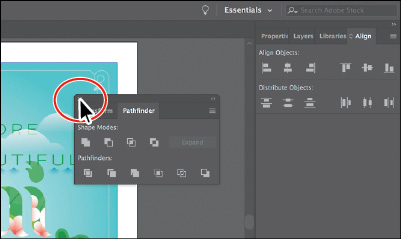
Aside from adding panels to the dock on the right, you can also remove them.
-
Drag the Align panel by the panel tab, to the left, away from the dock of panels,
and release the mouse button.
-
Click the X at the top of the Align panel to close it.
-
Click the Libraries panel tab on the right to show that panel, if it isn’t already.
Switching workspaces
When you first launch Illustrator, the Essentials workspace is showing. Illustrator
comes with a host of other default workspaces that can be used to set the workspace
for a variety of tasks. Next, you’ll switch workspaces to another default workspace
to learn about some new panels.
-
Click the workspace switcher in the Application bar above the docked panels to change
the workspace.
 Tip: Press Tab to toggle between hiding and showing all panels. You can hide or show all
panels at once, except for the Tools panel, by pressing Shift+Tab to toggle between
hide and show.
Tip: Press Tab to toggle between hiding and showing all panels. You can hide or show all
panels at once, except for the Tools panel, by pressing Shift+Tab to toggle between
hide and show.
You’ll see a number of workspaces listed, each with a specific purpose, that will
open panels and arrange the workspace to make it most conducive to that type of work.
-
Choose Layout from the workspace switcher menu to switch workspaces.
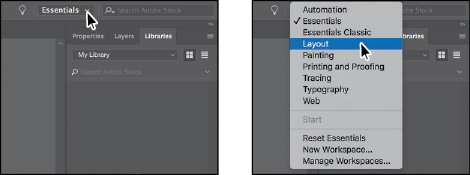
You’ll notice a few major changes in the workspace. One of the biggest is the Control
panel that’s now docked at the top of the workspace, just above the Document window
(an arrow is pointing to it in the following figure). Similar to the Properties panel,
it offers quick access to options, commands, and other panels relevant to the currently
selected content.
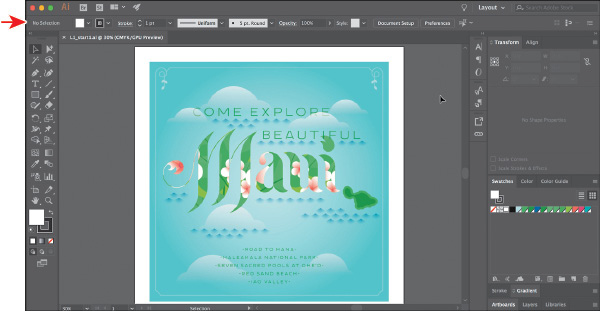
Also, notice all of the collapsed panel icons on the right side of the workspace.
In workspaces like Essential, you can create groups of panels that are stacked one
on another. This way, you can have a lot more panels showing.
-
Choose Essentials from the workspace switcher above the docked panels to switch back
to the Essentials workspace.
-
Choose Reset Essentials from the workspace switcher in the Application bar.
When you choose a previous workspace to switch to, it remembers any changes you made,
like selecting the Libraries panel. To completely reset a workspace, Essentials in
this case, to the default settings, you can choose to reset it.
Saving a workspace
So far, in this lesson, you’ve reset the workspace and chosen a different workspace.
You can also set up the panels the way you like and save your own custom workspace.
Next, you’ll dock a new panel and create your own workspace.
-
Choose Window > Artboards to open the Artboards panel group.
-
Drag the Artboards panel by the panel tab onto the Properties panel tab at the top
of the dock on the right. When a blue highlight appears around the entire panel dock,
release the mouse button to dock the Artboards panel.
 Note: To delete saved workspaces, choose Window > Workspace > Manage Workspaces. Select
the workspace name, and click the Delete Workspace button.
Note: To delete saved workspaces, choose Window > Workspace > Manage Workspaces. Select
the workspace name, and click the Delete Workspace button.
 Tip: To change a saved workspace, reset the panels as you’d like them to appear and then
choose Window > Workspace > New Workspace. In the New Workspace dialog box, name the
workspace with the original name. A message appears in the dialog box warning that
you will overwrite an existing workspace with the same name if you click OK.
Tip: To change a saved workspace, reset the panels as you’d like them to appear and then
choose Window > Workspace > New Workspace. In the New Workspace dialog box, name the
workspace with the original name. A message appears in the dialog box warning that
you will overwrite an existing workspace with the same name if you click OK.
-
Click the X at the top of the free-floating Asset Export panel to close it.
-
Choose Window > Workspace > New Workspace. Change Name to My Workspace in the New Workspace dialog box, and click OK.
The name of the workspace could be anything, as long as it makes sense to you. The
workspace named “My Workspace” is now saved with Illustrator until you remove it.
-
Choose Window > Workspace > Essentials.
-
Choose Window > Workspace > Reset Essentials.
Notice that the panels return to their default positions.
-
Choose Window > Workspace > My Workspace. Toggle between the two workspaces using
the Window > Workspace command, and return to the Essentials workspace before starting
the next exercise.
Using panel and context menus
Most panels in Illustrator have more options available in a panel menu, found by clicking
the panel menu icon ( or
or  ) in the upper-right corner of a panel. These additional options can be used to change
the panel display, add or change panel content, and more. Next, you’ll change the
display of the Swatches panel using its panel menu.
) in the upper-right corner of a panel. These additional options can be used to change
the panel display, add or change panel content, and more. Next, you’ll change the
display of the Swatches panel using its panel menu.
-
With the Selection tool ( ) selected in the Tools panel on the left, click the blue shape in the background
of the artwork again.
) selected in the Tools panel on the left, click the blue shape in the background
of the artwork again.
-
Click the Fill color box, to the left of the word “Fill,” in the Properties panel.
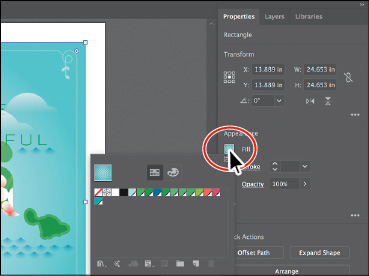
-
In the panel that appears, make sure that the Swatches option ( ) is selected. Click the panel menu icon (
) is selected. Click the panel menu icon ( ) in the upper-right corner, and choose Small List View from the panel menu.
) in the upper-right corner, and choose Small List View from the panel menu.

This displays the swatch names, together with thumbnails. Because the options in the
panel menu apply only to the active panel, only the Swatches panel view is affected.
-
Click the same panel menu icon ( ) in the panel showing, and choose Small Thumbnail View to return the swatches to
their original view.
) in the panel showing, and choose Small Thumbnail View to return the swatches to
their original view.
In addition to the panel menus, context-sensitive menus display commands relevant
to the active tool, selection, or panel. Usually the commands in a context menu are
available in another part of the workspace, but using a context menu can save you
time.
-
Choose Select > Deselect.
-
Position the pointer over the dark gray area surrounding the white area of the artboard.
Then, right-click to show a context menu with specific options.
The context-sensitive menu you see may contain different commands, depending on what
the pointer is positioned over.
 Note: If you position the pointer over the tab or title bar for a panel and right-click,
you can close a panel or a panel group in the context menu that appears.
Note: If you position the pointer over the tab or title bar for a panel and right-click,
you can close a panel or a panel group in the context menu that appears.
Changing the view of artwork
When working in files, it’s likely that you’ll need to change the magnification level
and navigate among artboards. The magnification level, which can range from 3.13%
to 64000%, is displayed in the title bar (or document tab) next to the filename and
in the lower-left corner of the Document window.
There are a lot of ways to change the zoom level in Illustrator, and in this section
you’ll explore several of the most widely used methods.
Using view commands
To enlarge or reduce the view of artwork using the View menu, do one of the following:
 Tip: You can also zoom in using the keyboard shortcut Command++ (macOS) or Ctrl++ (Windows).
That’s Command and + (macOS) or Ctrl and + (Windows). You can also zoom out using the keyboard shortcut Command+– (macOS)
or Ctrl+– (Windows). That’s Command and – (macOS) or Ctrl and – (Windows).
Tip: You can also zoom in using the keyboard shortcut Command++ (macOS) or Ctrl++ (Windows).
That’s Command and + (macOS) or Ctrl and + (Windows). You can also zoom out using the keyboard shortcut Command+– (macOS)
or Ctrl+– (Windows). That’s Command and – (macOS) or Ctrl and – (Windows).
Each time you choose a Zoom option, the view of the artwork is resized to the closest
preset zoom level. Using any of the viewing tools and commands affects only the display
of the artwork, not the actual size of the artwork. The preset zoom levels appear
in a menu in the lower-left corner of the Document window, identified by a down arrow
next to a percentage. If you have artwork selected, using the View > Zoom In view
command will zoom into what is selected.
You can also use the View menu to fit the active artboard to your screen, to fit all artboards into the view area, or to view artwork
at actual size. The active artboard is the selected artboard. Artboards represent
the regions that can contain printable artwork (similar to pages in a program like
Adobe InDesign). The artboard is indicated by a red line I added to the following
figure.
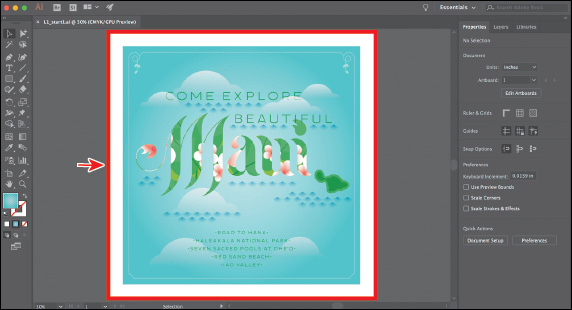
-
Choose View > Fit Artboard In Window.
 Tip: You can also double-click the Hand tool (
Tip: You can also double-click the Hand tool ( ) in the Tools panel to fit the active artboard in the Document window.
) in the Tools panel to fit the active artboard in the Document window.
 Tip: You can also double-click the Zoom tool (
Tip: You can also double-click the Zoom tool ( ) in the Tools panel to display artwork at 100%.
) in the Tools panel to display artwork at 100%.
By choosing View > Fit Artboard In Window or by using the keyboard shortcut Command+0
(macOS) or Ctrl+0 (Windows), the artboard is centered in the Document window.
-
Choose View > Actual Size to display the artwork at actual size.
The artwork is displayed at 100%. The actual size of your artwork determines how much
of it can be viewed onscreen at 100%.
-
Choose View > Fit Artboard In Window before continuing to the next section.
Using the Zoom tool
In addition to the View menu options, you can use the Zoom tool ( ) to magnify and reduce the view of artwork to predefined magnification levels.
) to magnify and reduce the view of artwork to predefined magnification levels.
-
Select the Zoom tool ( ) in the Tools panel and then move the pointer into the Document window.
) in the Tools panel and then move the pointer into the Document window.
Notice that a plus sign (+) appears at the center of the Zoom tool pointer.
-
Position the Zoom tool over the text “Maui” in the center of the artboard and click
once.

The artwork is displayed at a higher magnification. Notice that where you clicked
is now in the center of the Document window.
-
Click two more times on the Maui text. The view is increased again, and you’ll notice
that the area you clicked is magnified.
-
With the Zoom tool still selected, hold down the Option (macOS) or Alt (Windows) key.
A minus sign (–) appears at the center of the Zoom tool pointer. With the Option or
Alt key pressed, click the artwork twice to reduce the view of the artwork.
Using the Zoom tool, you can also drag in the document to zoom in and out. By default,
if your computer meets the system requirements for GPU Performance and it’s enabled,
zooming is animated. To find out if your computer meets the system requirements, see
the sidebar titled “GPU Performance” following this section.
-
Choose View > Fit Artboard In Window.
-
With the Zoom tool still selected, click and drag from the left side of the document
to the right to zoom in. The zooming is animated. Drag from right to left to zoom
out.
 Note: If your computer does not meet the system requirements for GPU Performance, you will instead draw a dotted
rectangle, called a marquee, when dragging with the Zoom tool.
Note: If your computer does not meet the system requirements for GPU Performance, you will instead draw a dotted
rectangle, called a marquee, when dragging with the Zoom tool.
 Tip: With the Zoom tool selected, if you move the pointer into the Document window and
press the mouse button for a few seconds, you can zoom in using the animated zoom.
Once again, this will work if your computer meets the system requirements for GPU
Performance and it’s enabled.
Tip: With the Zoom tool selected, if you move the pointer into the Document window and
press the mouse button for a few seconds, you can zoom in using the animated zoom.
Once again, this will work if your computer meets the system requirements for GPU
Performance and it’s enabled.
 Note: In certain versions of macOS, the keyboard shortcuts for the Zoom tool (
Note: In certain versions of macOS, the keyboard shortcuts for the Zoom tool ( ) open Spotlight or the Finder. If you decide to use these shortcuts in Illustrator,
you may want to turn off or change those keyboard shortcuts in the macOS System Preferences.
) open Spotlight or the Finder. If you decide to use these shortcuts in Illustrator,
you may want to turn off or change those keyboard shortcuts in the macOS System Preferences.
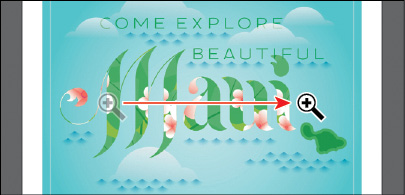
-
Double-click the Hand tool ( ) in the Tools panel to fit the artboard in the Document window.
) in the Tools panel to fit the artboard in the Document window.
The Zoom tool is used frequently during the editing process to enlarge and reduce
the view of artwork. Because of this, Illustrator allows you to select it using the
keyboard at any time without first deselecting any other tool you may be using.
-
To access the Zoom tool using your keyboard, press Command+spacebar (macOS) or Ctrl+spacebar
(Windows).
-
To access the Zoom Out tool using your keyboard, press Command+Option+spacebar (macOS)
or Ctrl+Alt+spacebar (Windows).
Scrolling through a document
In Illustrator, you can use the Hand tool ( ) to pan to different areas of a document. Using the Hand tool allows you to push
the document around much like you would a piece of paper on your desk. This can be
a very useful way to move around in a document with a lot of artboards or when you
are zoomed in. In this section, you’ll access the Hand tool using a few methods.
) to pan to different areas of a document. Using the Hand tool allows you to push
the document around much like you would a piece of paper on your desk. This can be
a very useful way to move around in a document with a lot of artboards or when you
are zoomed in. In this section, you’ll access the Hand tool using a few methods.
-
With the Hand tool ( ) selected in the Tools panel, drag down in the Document window. As you drag, the
artwork moves with the hand.
) selected in the Tools panel, drag down in the Document window. As you drag, the
artwork moves with the hand.
As with the Zoom tool ( ), you can select the Hand tool with a keyboard shortcut without first deselecting
the active tool.
), you can select the Hand tool with a keyboard shortcut without first deselecting
the active tool.
-
Click any other tool except the Type tool ( ) in the Tools panel, and move the pointer into the Document window. Hold down the
spacebar on the keyboard to temporarily select the Hand tool and then drag to bring
the artwork back into the center of your view.
) in the Tools panel, and move the pointer into the Document window. Hold down the
spacebar on the keyboard to temporarily select the Hand tool and then drag to bring
the artwork back into the center of your view.
Viewing artwork
When you open a file, it is automatically displayed in Preview mode, which shows how
the artwork will print. Illustrator offers other ways of viewing your artwork, such
as outlines and rasterized. Next, you’ll take a look at the different methods for
viewing artwork and understand why you might view artwork that way.
-
Choose View > Fit Artboard In Window.
When you’re working with large or complex illustrations, you may want to view only
the outlines, or paths, of objects in your artwork so that the screen doesn’t have to redraw the artwork
each time you make a change. This is called Outline mode. Outline mode can also be
helpful when selecting objects, as you will see in Lesson 2, “Techniques for Selecting Artwork.”
-
Choose View > Outline.
Only the outlines of objects are displayed. You can use this view to find and select
objects that might not be visible in Preview mode.
 Tip: You can press Command+Y (macOS) or Ctrl+Y (Windows) to toggle between Preview and
Outline modes.
Tip: You can press Command+Y (macOS) or Ctrl+Y (Windows) to toggle between Preview and
Outline modes.
-
With Outline mode still showing, choose View > GPU Preview (or View > Preview On CPU
if GPU Preview is not supported) to see all the attributes of the artwork.
-
Choose View > Overprint Preview to view any lines or shapes that are set to overprint.
This view is helpful for those in the print industry who need to see how inks interact
when set to overprint.
 Note: When switching between viewing modes, visual changes may not be readily apparent.
Zooming in and out (View > Zoom In and View > Zoom Out) may help you see the differences
more easily.
Note: When switching between viewing modes, visual changes may not be readily apparent.
Zooming in and out (View > Zoom In and View > Zoom Out) may help you see the differences
more easily.
-
Choose View > Fit Artboard In Window.
-
Choose 400% from the zoom level menu in the lower-left corner of the application window.
-
Choose View > Pixel Preview.
When you turn on Pixel preview, Overprint preview is turned off. Pixel preview can
be used to see how the artwork will look when it is rasterized and viewed onscreen
in a web browser. Note the “jagged” edge on some of the artwork. An arrow is pointing
to it in the figure.
-
Choose View > Pixel Preview to turn off Pixel preview.
-
Choose View > Fit Artboard In Window to make sure that the entire active artboard
is fit in the Document window, and leave the document open.
Navigating artboards
Artboards represent the regions that can contain printable artwork (similar to pages
in a program like Adobe InDesign). You can use artboards to crop areas for printing
or placement purposes. Multiple artboards are useful for creating a variety of things,
such as multipage PDFs, printed pages with different sizes or different elements,
independent elements for websites, video storyboards, or individual items for animation
in Adobe® Animate CC or Adobe After Effects® CC. You can easily share content among designs, create multipage PDFs, and print
multiple pages by creating more than one artboard.
Illustrator allows for up to 1,000 artboards within a single file (depending on their
size). Multiple artboards can be added when you initially create an Illustrator document,
or you can add, remove, and edit artboards after the document is created. Next, you
will learn how to efficiently navigate a document that contains multiple artboards.
-
Choose File > Open. In the Open dialog box, navigate to the Lessons > Lesson01 folder,
and select the L1_start2.ai file on your hard disk. Click Open to open the file.
-
Choose View > Fit All In Window to fit all artboards in the Document window. Notice
that there are two artboards in the document that contain the designs for the front
and back of a postcard.
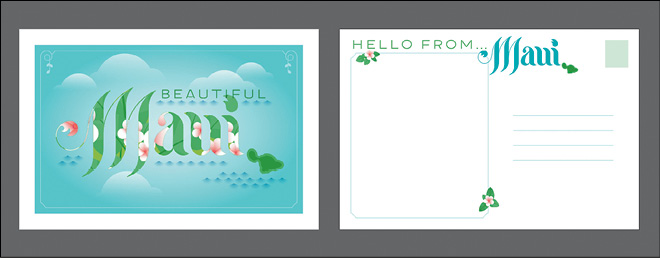
The artboards in a document can be arranged in any order, orientation, or artboard
size—they can even overlap. Suppose that you want to create a four-page brochure.
You can create different artboards for every page of the brochure, all with the same
size and orientation. They can be arranged horizontally or vertically or in whatever
way you like.
-
Select the Selection tool ( ) in the Tools panel, and click to select the “HELLO FROM” text objects on the artboard
on the right.
) in the Tools panel, and click to select the “HELLO FROM” text objects on the artboard
on the right.
-
Choose View > Fit Artboard In Window.
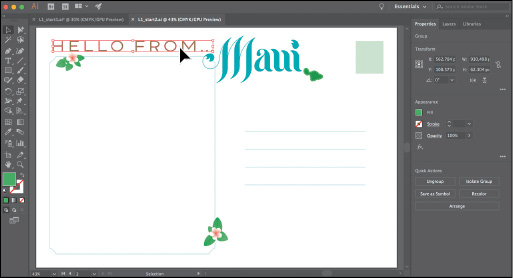
When you select artwork, it makes the artboard that the artwork is on the active, or selected, artboard. By choosing the Fit Artboard In Window command, the currently
active artboard is fit in the Document window. The active artboard is identified in
the Artboard Navigation menu in the lower-left corner of the Document window. Currently
it is artboard 2.
-
Choose Select > Deselect to deselect the text.
-
Choose 1 from the Artboard Navigation menu in the Properties panel.
Notice the arrows to the right of the Artboard Navigation menu in the Properties panel.
You can use these to navigate to the previous ( ) and next (
) and next ( ) artboards. Those arrows plus a few others also appear in the Status bar below the
document.
) artboards. Those arrows plus a few others also appear in the Status bar below the
document.
-
Click the Next navigation button ( ) in the Status bar below the document to view the next artboard (artboard 2) in the
Document window.
) in the Status bar below the document to view the next artboard (artboard 2) in the
Document window.

The Artboard Navigation menu and navigation arrows always appear in the Status bar
below the document, but only appear in the Properties panel when not in Artboard Editing
mode, the Selection tool is selected, and nothing is selected.
Using the Artboards panel
Another method for navigating multiple artboards is to use the Artboards panel. The
Artboards panel lists all artboards currently in the document and allows you to navigate
between artboards, rename artboards, add or delete artboards, edit artboard settings,
and more. Next, you’ll open the Artboards panel and navigate the document.
-
Choose Window > Artboards to open the Artboards panel.
-
Double-click the number 1 that appears to the left of the name “Front” in the Artboards
panel. The artboard named Front is now fit in the Document window.
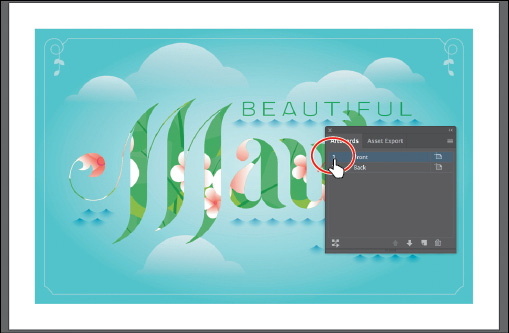
-
Double-click the number 2 to the left of the name “Back” in the Artboards panel to
show the second artboard in the Document window.
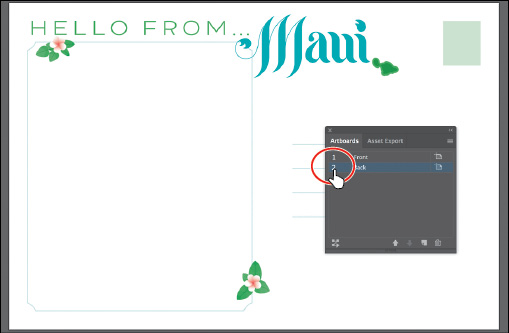
Notice that when you double-click to navigate to an artboard, that artboard is also
fit in the Document window.
-
Click the X at the top of the Artboards panel group to close it.
Arranging multiple documents
There will be times when you open more than one Illustrator document at a time. When
you open more than one document, the Document windows are tabbed. You can arrange
the open documents in other ways, such as side by side, so that you can easily compare
or drag items from one document to another. You can also use the Arrange Documents
menu to quickly display your open documents in a variety of configurations.
You should currently have two Illustrator files open: L1_start1.ai and L1_start2.ai.
Each file has its own tab at the top of the Document window. These documents are considered
a group of Document windows. You can create document groups to loosely associate files
while they are open.
-
Click the L1_start1.ai document tab to show L1_start1.ai in the Document window.
-
Drag the L1_start1.ai document tab to the right of the L1_start2.ai document tab.
Release the mouse button to see the new tab order.

Dragging the document tabs allows you to change the order of the documents. This can
be very useful if you use the document shortcuts to navigate to the next or previous
document.
 Note: Be careful to drag directly to the right. Otherwise, you could undock the Document
window and create a new group. If that happens, choose Window > Arrange > Consolidate
All Windows.
Note: Be careful to drag directly to the right. Otherwise, you could undock the Document
window and create a new group. If that happens, choose Window > Arrange > Consolidate
All Windows.
 Tip: You can cycle between open documents by pressing Command+~ (next document) and Command+Shift+~
(previous document) (macOS) or by pressing Ctrl+F6 (next document) and Ctrl+Shift+F6
(previous document) (Windows).
Tip: You can cycle between open documents by pressing Command+~ (next document) and Command+Shift+~
(previous document) (macOS) or by pressing Ctrl+F6 (next document) and Ctrl+Shift+F6
(previous document) (Windows).
To see both of the documents at the same time, maybe to drag artwork from one to the
other, you can arrange the Document windows by cascading or tiling them. Cascading allows you to cascade (stack) different document groups. Tiling shows multiple Document windows at one time, in various arrangements. Next, you’ll
tile the open documents so that you can see both documents at one time.
-
Choose Window > Arrange > Tile.
This shows both Document windows arranged in a pattern.
 Note: On macOS, the Application Frame needs to be turned on (Window > Application Frame)
for tiling to work in this step.
Note: On macOS, the Application Frame needs to be turned on (Window > Application Frame)
for tiling to work in this step.
 Note: Your documents may be tiled in a different order. That’s okay.
Note: Your documents may be tiled in a different order. That’s okay.
-
Click in the Document window on the left to activate the document, and choose View
> Fit Artboard In Window. Do the same for the Document window on the right.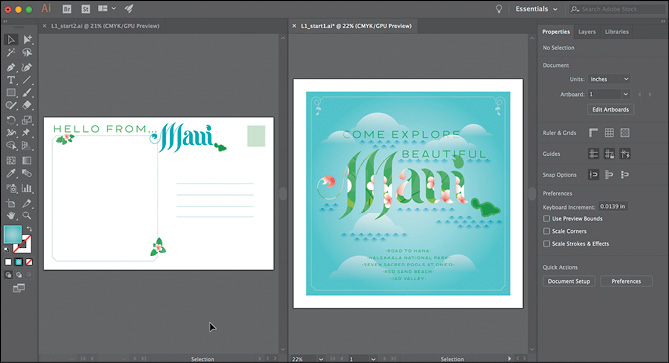
 Note: In Illustrator, all the workspace elements are grouped in a single, integrated window
that lets you treat the application as a single unit. When you move or resize the
Application frame or any of its elements, all the elements within it respond to each
other so none overlaps another. If you are using a Mac and prefer the traditional,
free-form user interface, you can turn off the Application frame by choosing Window
> Application Frame to toggle it on or off.
Note: In Illustrator, all the workspace elements are grouped in a single, integrated window
that lets you treat the application as a single unit. When you move or resize the
Application frame or any of its elements, all the elements within it respond to each
other so none overlaps another. If you are using a Mac and prefer the traditional,
free-form user interface, you can turn off the Application frame by choosing Window
> Application Frame to toggle it on or off.
With documents tiled, you can drag the dividing line between each of the Document
windows to reveal more or less of a particular document. You can also drag artwork
between documents, which copies them from one document to another.
To change the arrangement of the tiled windows, it’s possible to drag document tabs
to new positions. However, it’s easier to use the Arrange Documents menu to quickly
arrange open documents in a variety of configurations.
-
Click the Arrange Documents button ( ) in the Application bar to display the Arrange Documents menu. Click the Consolidate
All button (
) in the Application bar to display the Arrange Documents menu. Click the Consolidate
All button ( ) to bring the documents back together.
) to bring the documents back together.
 Note: On Windows, menus appear in the Application bar.
Note: On Windows, menus appear in the Application bar.
 Tip: You can also choose Window > Arrange > Consolidate All Windows to return the two
documents to tabs in the same group.
Tip: You can also choose Window > Arrange > Consolidate All Windows to return the two
documents to tabs in the same group.
-
Click the Arrange Documents button ( ) in the Application bar to display the Arrange Documents menu again. Click the 2-Up
vertical button (
) in the Application bar to display the Arrange Documents menu again. Click the 2-Up
vertical button ( ) in the Arrange Documents menu.
) in the Arrange Documents menu.
-
Click to select the L1_start1.ai tab, if it is not already selected. Then, click the
Close button (X) on the L1_start1.ai document tab to close the document. If a dialog
box appears asking you to save the document, click Don’t Save (macOS) or No (Windows).

-
Choose File > Close to close the L1_start2.ai document without saving.
Finding resources for using Illustrator
 Tip: The Learn panel, which contains instructional content, was added just prior to release.
To access it, open a file and either choose Window > Learn or click the Learn icon
(
Tip: The Learn panel, which contains instructional content, was added just prior to release.
To access it, open a file and either choose Window > Learn or click the Learn icon
( ) in the Application bar.
) in the Application bar.
To access Illustrator tutorials, close all open files and click the Learn tab at the
top of the Start workspace. You will find links to video and written tutorials on
a variety of Illustrator-related topics.

For complete and up-to-date information about using Illustrator panels, tools, and
other application features, visit the Adobe website. By choosing Help > Illustrator
Help, you’ll be connected to the Illustrator Help website, where you can search Illustrator
Help and support documents, as well as other websites relevant to Illustrator users.
Community Help brings together active Adobe product users, Adobe product team members,
authors, and experts to give you the most useful, relevant, and up-to-date information
about Adobe products.











 ) in the Tools panel. Notice that the name (Selection Tool) and keyboard shortcut
(V) are displayed in a tooltip.
) in the Tools panel. Notice that the name (Selection Tool) and keyboard shortcut
(V) are displayed in a tooltip.

 ), and click and hold down the mouse button until a tools menu appears. Release the
mouse button and then click the Group Selection tool to select it.
), and click and hold down the mouse button until a tools menu appears. Release the
mouse button and then click the Group Selection tool to select it.

 ) to reveal more tools. Click the arrow at the right edge of the hidden tools panel
to separate the tools from the Tools panel so that you can access them at all times.
) to reveal more tools. Click the arrow at the right edge of the hidden tools panel
to separate the tools from the Tools panel so that you can access them at all times.





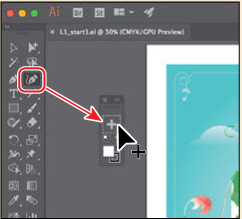



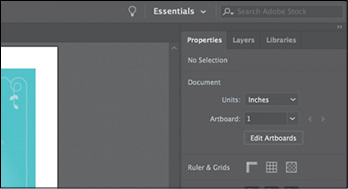










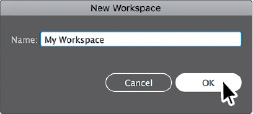
 or
or  ) in the upper-right corner of a panel. These additional options can be used to change
the panel display, add or change panel content, and more. Next, you’ll change the
display of the Swatches panel using its panel menu.
) in the upper-right corner of a panel. These additional options can be used to change
the panel display, add or change panel content, and more. Next, you’ll change the
display of the Swatches panel using its panel menu.
 ) selected in the Tools panel on the left, click the blue shape in the background
of the artwork again.
) selected in the Tools panel on the left, click the blue shape in the background
of the artwork again.

 ) is selected. Click the panel menu icon (
) is selected. Click the panel menu icon ( ) in the upper-right corner, and choose Small List View from the panel menu.
) in the upper-right corner, and choose Small List View from the panel menu.

 ) in the panel showing, and choose Small Thumbnail View to return the swatches to
their original view.
) in the panel showing, and choose Small Thumbnail View to return the swatches to
their original view.
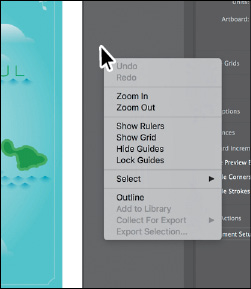
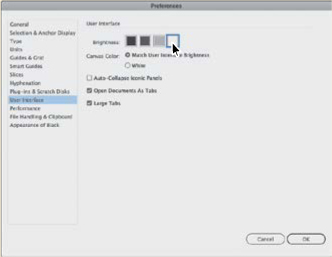

 ) in the Tools panel to fit the active artboard in the Document window.
) in the Tools panel to fit the active artboard in the Document window.
 ) in the Tools panel to display artwork at 100%.
) in the Tools panel to display artwork at 100%.
 ) to magnify and reduce the view of artwork to predefined magnification levels.
) to magnify and reduce the view of artwork to predefined magnification levels.

 ) open Spotlight or the Finder. If you decide to use these shortcuts in Illustrator,
you may want to turn off or change those keyboard shortcuts in the macOS System Preferences.
) open Spotlight or the Finder. If you decide to use these shortcuts in Illustrator,
you may want to turn off or change those keyboard shortcuts in the macOS System Preferences.

 ) in the Tools panel to fit the artboard in the Document window.
) in the Tools panel to fit the artboard in the Document window.

 ), you can select the Hand tool with a keyboard shortcut without first deselecting
the active tool.
), you can select the Hand tool with a keyboard shortcut without first deselecting
the active tool.
 ) in the Tools panel, and move the pointer into the Document window. Hold down the
spacebar on the keyboard to temporarily select the Hand tool and then drag to bring
the artwork back into the center of your view.
) in the Tools panel, and move the pointer into the Document window. Hold down the
spacebar on the keyboard to temporarily select the Hand tool and then drag to bring
the artwork back into the center of your view.
 ) does not work when the Type tool (
) does not work when the Type tool ( ) is active and the cursor is in text. To access the Hand tool when the cursor is in text, press
the Option (macOS) or Alt (Windows) key.
) is active and the cursor is in text. To access the Hand tool when the cursor is in text, press
the Option (macOS) or Alt (Windows) key.


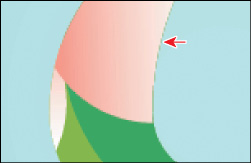
 ), drag to pan to different parts of the artwork.
), drag to pan to different parts of the artwork.
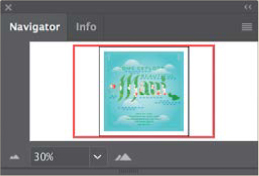



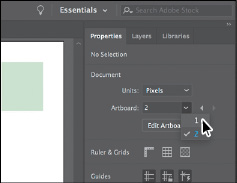
 ) and next (
) and next ( ) artboards. Those arrows plus a few others also appear in the Status bar below the
document.
) artboards. Those arrows plus a few others also appear in the Status bar below the
document.





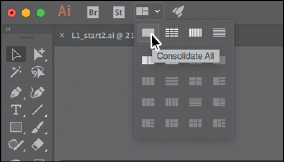
 ) in the Application bar to display the Arrange Documents menu. Click the Consolidate
All button (
) in the Application bar to display the Arrange Documents menu. Click the Consolidate
All button ( ) to bring the documents back together.
) to bring the documents back together.
 ) in the Application bar to display the Arrange Documents menu again. Click the 2-Up
vertical button (
) in the Application bar to display the Arrange Documents menu again. Click the 2-Up
vertical button ( ) in the Arrange Documents menu.
) in the Arrange Documents menu.

 ) in the Application bar.
) in the Application bar.


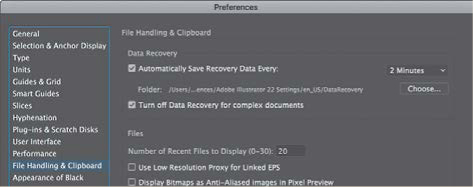
 ) in the Tools panel and click or drag over a document to enlarge or reduce the view.
In addition, you can use keyboard shortcuts to magnify or reduce the display of artwork.
You can also use the Navigator panel to scroll artwork or to change its magnification
without using the Document window.
) in the Tools panel and click or drag over a document to enlarge or reduce the view.
In addition, you can use keyboard shortcuts to magnify or reduce the display of artwork.
You can also use the Navigator panel to scroll artwork or to change its magnification
without using the Document window.